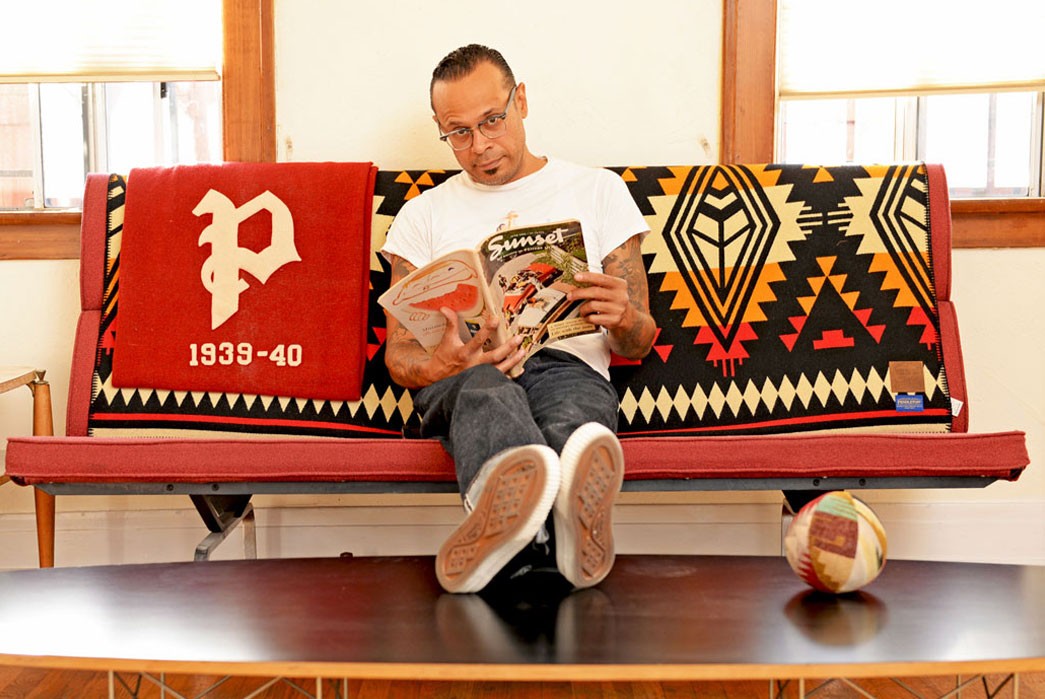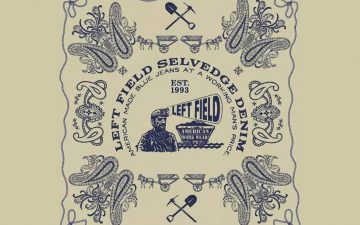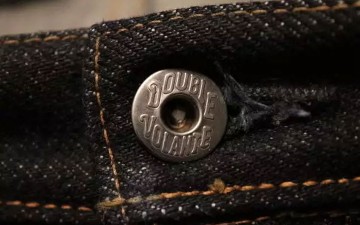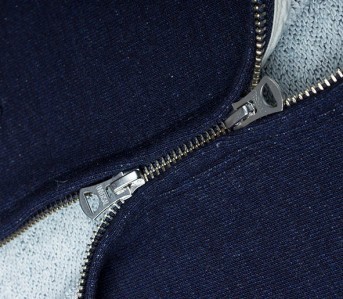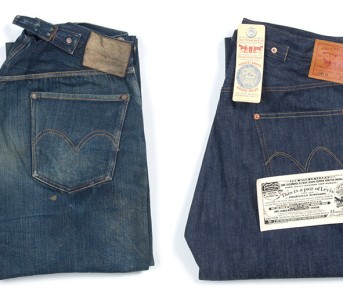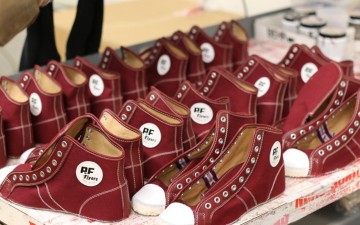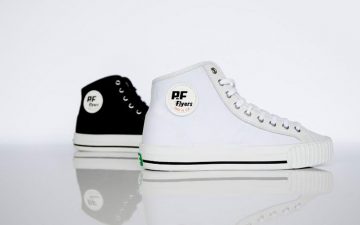Though first and foremost a skateboarder, Alyasha Owerka-Moore has donned a handful of hats since breaking into the apparel industry nearly thirty years ago, including: designer, creative director, entrepreneur, and more recently, brand historian. Indeed, through either helming or helping shape several pivotal brands–e.g. Phat Farm, Alphanumeric, Fiberops–Alyasha has not only developed one prolific and impressive resume, but also gained a deep knowledge of and appreciation for contemporary American pop culture and the world of heritage.
Now a part of the PF Flyers team as their Brand Historian, Alyasha is helping revitalize the heritage footwear brand by bridging the gap from 75 years ago to today. Even If you already know of the force that is “Stackaly” (or simply “Aly” to others), read on for our two-part conversation covering his experiences thus far, genuine admiration for PF Flyers, the footwear brand’s rich history, and why they are still relevant today.
Heddels: For those unacquainted with you and your work, can you walk us through your background and how you found yourself to be a part of PF Flyers?
Alyasha Owerka-Moore: I got into clothing design through my mother, a textile conservator, who taught me to sew, was a big fan of fashion and design. One of her degrees is in art education and art history, so she raised me in a creative household. Then in the 80’s I got into skateboarding through my friend, Paul Mittleman, who ended up being the creative director for Stussy. Later rockabilly and vintage fashion through my high school girlfriend, Heather Worley, who ended up going on to design for Knoll.
I ran with a team of skater cats in New York City called “Shut Skates“, we hand-cut a hundred boards or so on my mom’s roof in Brooklyn. My friend, Eli Gessner, and I did all the original graphics for the boards, and we stenciled or hand painted them. Shut Skates went on to become an actual business and New York’s first skateboard company, which morphed into Zoo York–with Eli being their Creative Director–and then back into Shut Skates later.
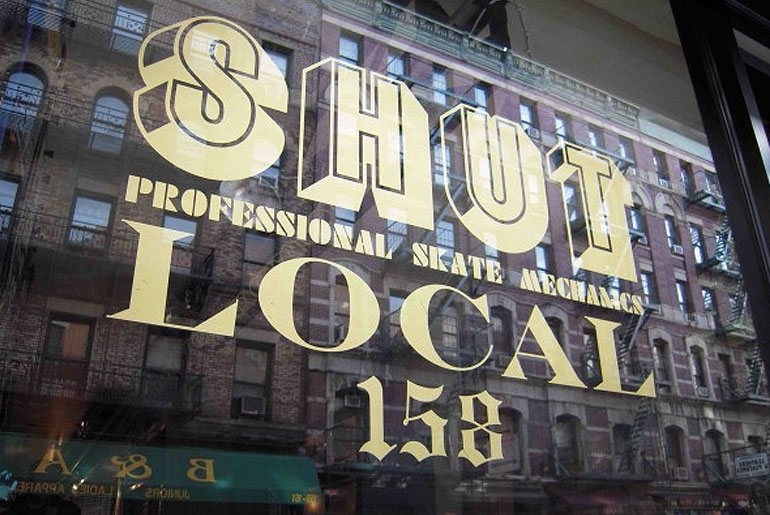
Shut Skates’ storefront – 158 Orchard Street, NYC
Worked for TransWorld Skateboarding Magazine in in the design dept, briefly. I went back to New York City, somehow fell into a position working along with Russell Simmons, and created the concept of Phat Farm for him. While at Phat Farm I was lucky enough to get to work with Dwight Tanner, a tailor, pattern maker and production manager and learned a lot about pattern making, sewing and production. Basically, it was like having a grant to go to design school because I was working for so long alongside technical designers.
Shortly after Phat Farm I created a skateboard brand called “American Dream Incorporated” with Delux distribution, then got offered a job by a company called Circus Distribution, at the time, the holding company for DC Shoes, Dub Brand Outerwear, and Droors Denim. I became a senior designer for Dub and Droors.
I was designing technical outerwear and denim for them for two and a half years, snowboarding every weekend, and then I had this concept in my head about an all-encompassing brand, making really nice denim and outerwear. I saw a virgin lifestyle I guess amongst what would be proto streetwear, where you had guys that skated buying better quality and designed things (for example, selvedge jeans), wearing North Face, Patagonia, and Arc’teryx. They were buying nice outerwear pieces whether they were in the mountains or in the city, and with all of this in mind, I had come up with a concept called “Alphanumeric”.
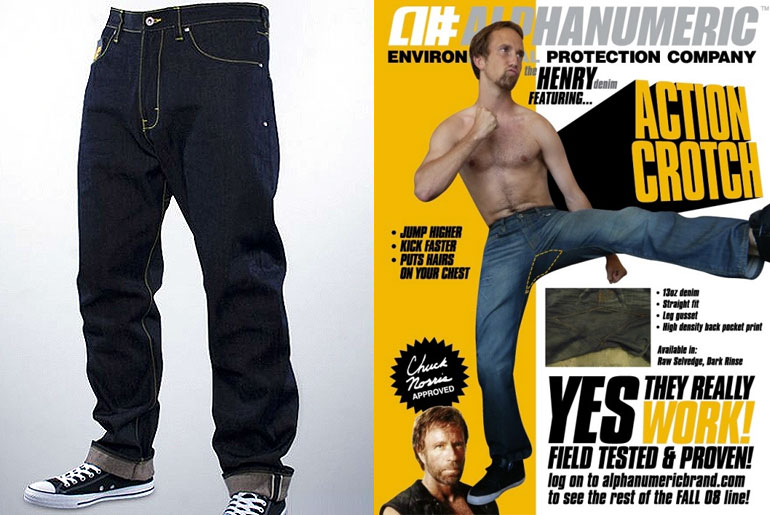
The “Henry” raw selvedge denim (left) and accompanying promotional material – just two of Alphanumerics creations.
While working on Alphanumeric after a few years during the late 90’s, I had been put on a “seeding list” with Nike and ended up speaking with a gentleman named Drew Greer, who developed the Nike LE (Limited Edition) program, is responsible for bringing back Air Max 95, and singlehandedly found the last for the Dunk. He asked me what I thought of the Dunk and since they were starting a Nike skateboarding program, if Alphanumeric would be interested in doing some sort of collaborative shoe; which resulted in the Alphanumeric Dunk. The First Dunk Collaboration after the Wu-Tang Dunk.
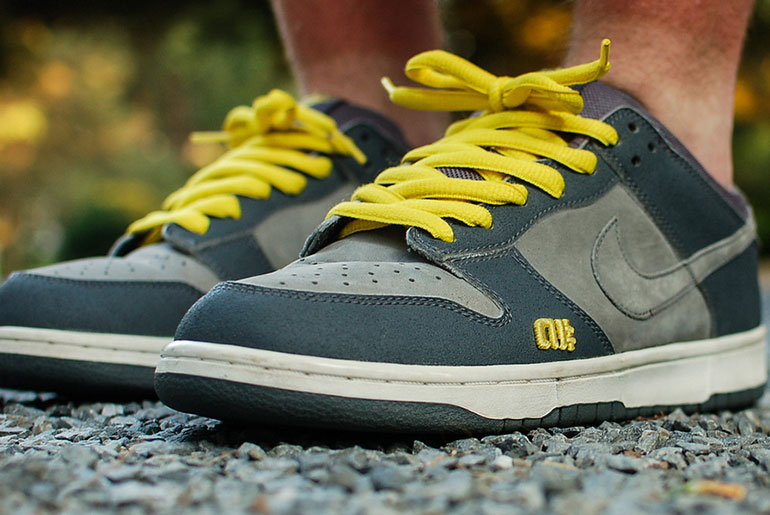
Alphanumeric Nike Dunk. Image via Sweet Soles.
In 2012, I’d reconnected with my old friend Frank the Butcher, and told him I’d sold off my sneaker collection back in 2007-8, and had only been buying and wearing PF Flyers because I dug the aesthetic and history of the shoes and nerding out on it’s original branding. I had just been buying old PF signage, point of sale cards and the like, and I just thought PF was a fascinating brand with a great history. It has such a rich history with a huge impact on contemporary American pop culture, which most people didn’t realize because it hadn’t been on the map. It was just a genuine heritage brand, especially in a period of time where so many people are trying to create this false sense of heritage, you know.
So he said, “why aren’t you working with them?”, I said “well, I don’t know anybody there”, and he said, “hold on I’ll call you right back.” And roughly ten minutes later I get an email introducing me to Victor Aviles, PF Flyer’s GM, and after several exchanges, I flew out to Boston, MA. I got to meet the team and I was just blown away at the archive that they had put together in between 2001 and 2012. This is around the time I started working with them as a brand ambassador. (Thank you, Frank!)
As we spent more time together and travelled together, I got to contribute to some product design and marketing. Ultimately, I’d like to work more behind the scene’s in more of a creative director capacity.
RD: You’ve been collecting sneakers and other paraphernalia for decades now and as the “Brand Historian” too, you’ve dug up some amazing vintage advertisements, store displays, comic books, etc. featuring PF Flyers. Where do you dig for old PF stuff? What is it about the brand that grabbed you when you were younger and still holds your attention today?
AOM: Most of the stuff I find at tag sales, swap meets, flea markets, rag houses, vintage shops, on eBay, and just wherever I can.
It’s important and fascinating to me because it has had such a powerful impact on American youth culture and other happenings that people don’t even realize PF was involved in. PF Flyers sponsored the Mickey Mouse Club – there are ads featuring Mickey Mouse, Donald Duck and Pluto all wearing PFs. There are point-of-sale cards with the message, “watch the Mickey Mouse Club, sponsored by PF Flyers at 7PM on blank station.” I mean, you can’t really get more influential than Disney. Those kind of partnerships that were made in the 40’s through 70’s were incredible and invaluable.

Two of P.F. Flyers’ old advertisements from Aly’s collection – their sponsorship of American Bandstand with Dick Clark (left) and Mickey Mouse Club.
They also sponsored Dick Clark’s American Bandstand, there’s point-of-sale cards with Dick Clark’s face and, “I’m the man with the sock hop, and wear PF Flyers.” BF Goodrich made boots, soles and rubberized canvas goods for a long time, and BF was PF Flyers parent company for most of its existence, from the 30’s into the 70’s. They made boots for the military, sneakers for basic training, they contributed to the war effort (WWII), they made rain gear, they made flotation devices for pilots and sailors, etc. BF also made the boots for the Gemini II space suits. Subsequently, all the astronauts in that program wore PF Flyers when they weren’t in their mission gear.
Even Jonny Quest. Jonny Quest saves Race Bannon wearing PF Flyers and using his PF Flyers Decoder Ring. I guess for some people it might not be interesting, but for me it was the first cartoon that had a jazz theme song. It was the first action-adventure cartoon, whereas for most of this kind of stuff, these shows would have been live action. There’s a whole bunch of interesting facts about Jonny Quest, but to me, just the fact that PF Flyers was associated is fascinating.
There is a whole other realm of pop culture influence as well. One thing that really keeps my attention is the fact that we took the time to make a shoe made completely here in the US. It’s important and necessary.
RD: What are some of the stranger items you’ve found from PF’s past?
AOM: I don’t know that any of it is strange. I think for me, if you look at advertising in the 40’s and 30’s, there are a lot of regular occurrences that might be odd today, like a creepy billiard clown. So I think a lot of it is whatever’s socially relevant at the time, I don’t think much of it is strange.
I think one of the most interesting things is an ad from the early 2000’s that Heckler [PF Flyers agency] put together, where there’s a vaccu-formed Swifty mask. Swifty’s the little mascot guy, nobody knows what he is. Nobody knows if he’s a chipmunk or flying squirrel or monkey. I think he’s probably some sort of rodent and regardless, I think he’s pretty cool. Anyway, there’s this weird fluorescent vaccu-formed mask of Swifty that I’d love to see in real life. That’s probably the strangest or most interesting thing I’ve seen.
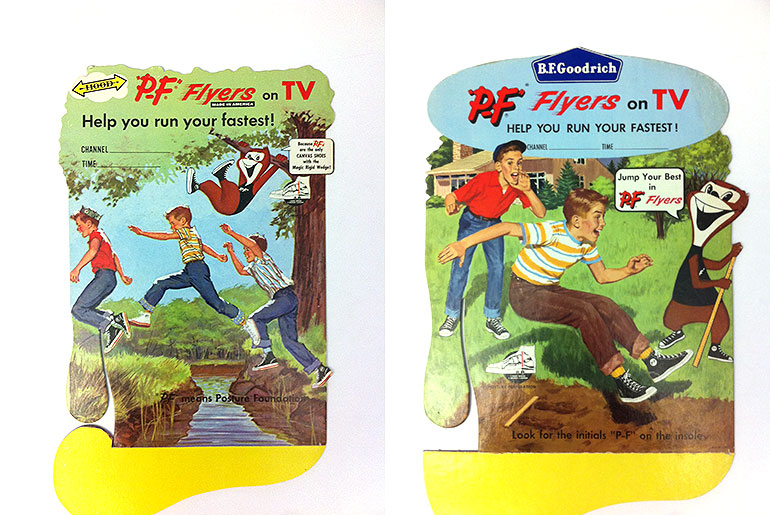
P.F. Flyers and their trusty mascot, Swifty, helping kids run faster.
A lot of the other stuff are things like the Decoder Ring, compasses, or PF Flyer’s arrowhead whistle. A lot of people forget that kids spent a lot of time outdoors climbing trees, climbing rocks, camping, and hiking and all that stuff was very much a part of American youth culture for a long time.
So some people might think they’re strange, but they’re not. They’re in league with the Daisy Red Rider BB Gun or the Red Rider First Boy’s Outdoors Knife, which was like a crazy billy knife that was given to five-year olds. But again, it’s a different culture. I had a Handy Andy toolset when I was six, which included a Philip’s head screwdriver, a knife, a hammer, a vice, and pliers; but just kid’s size. And they’re all metal. You couldn’t sell that now. So it’s just a different culture.
RD: How do you go about forensically reconstructing the identity of a company from 50 years ago?
AOM: By creating parallels. There are a lot of things that are parallel and relevant right now culturally. There’s this huge outdoors revival right now. Get up, unplug, and go. Everybody’s hiking again, everybody’s camping again, everybody’s talking about and enjoying nature again. There’s a huge DIY and craftsmanship culture now, versus when there was once was a period that the average man knew how to make a cabinet, knew how to start a fire, etc.
So we show that that existed within the brand and within the culture of the brand, and showing that it still does. A lot of it is through catalogs or through photos from PF’s archive, but showing cultural parallels and contemporary relevance from the past into the present.
RD: What’s something you think most people would find surprising about PF Flyers?
AOM: I think many of things I mentioned earlier: their relationship with Disney, their relationship with NASA, and their relationship with Dick Clark. You know, though PF doesn’t intend on being a skateboard brand, we have legitimacy. And a legitimate history in skateboarding, basically because people were skating in PFs before Vans even existed.
A lot of it has to do with the timeline. Because of the relationship with BF Goodrich, there’s a huge, genuine outdoor connection. We made a shoe called the “Grounder” in the 40’s. Basically it took the prototypical or classic upper of the center, the canvas athletic high-top shoe, and somebody had the wherewithal of affixing a rubber lug sole that came off a BF Goodrich’s wading boot from the 40’s, the Wade Light.
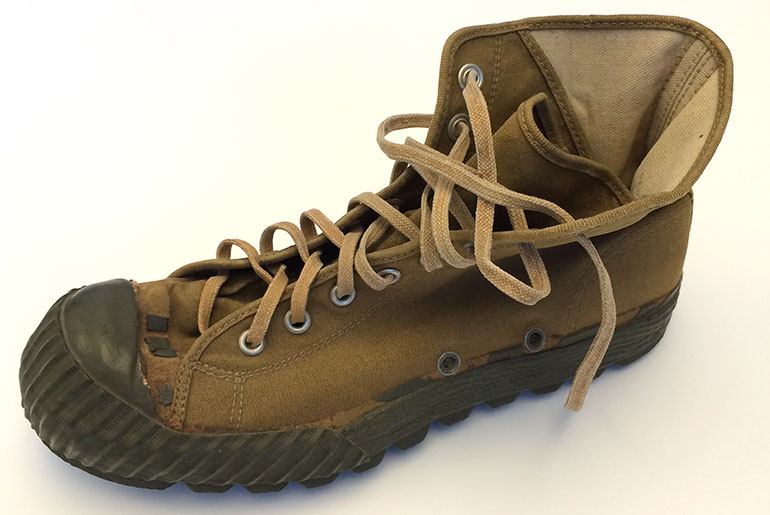
PF Flyers’ original Wade-Lite
One thing people don’t realize is that public schools started implementing mandatory athletics then, and as suburbia grew after the war, you had more and more kids playing outdoor sports whether it be football or baseball in sandlots. So the Grounder was made to be this kind of outdoor sandlot shoe with a tread action sole and there are ads showing these kids hiking in it. And just from the clothing that they’re wearing, it’s gotta be late 40’s or mid-40’s.
I’ve mentioned this before, but our involvement with the military during World War 2. PF Flyers, along with the two other big brands, made all sorts of rubberized goods and shoes for all branches of the military. The branding lines get blurred between PF Flyers and BF Goodrich then, but that was the case with other sneaker companies at the time since they all were owned by rubber companies. Keds was owned by US Rubber, the other big name was started as a rubber company, not a sneaker company.
Then you had Colchester, which is basically the grandfather of them all and the original vulcanized athletic shoe. Another thing one might find surprising is that we make a shoe in the US and are presently working on a few other styles that will be produced in the US.
Stay tuned for Part II of our interview with Alyasha. For more information on PF Flyers, visit their website. Portrait image source: Tim Hardy.
